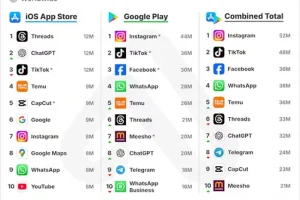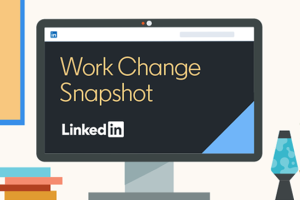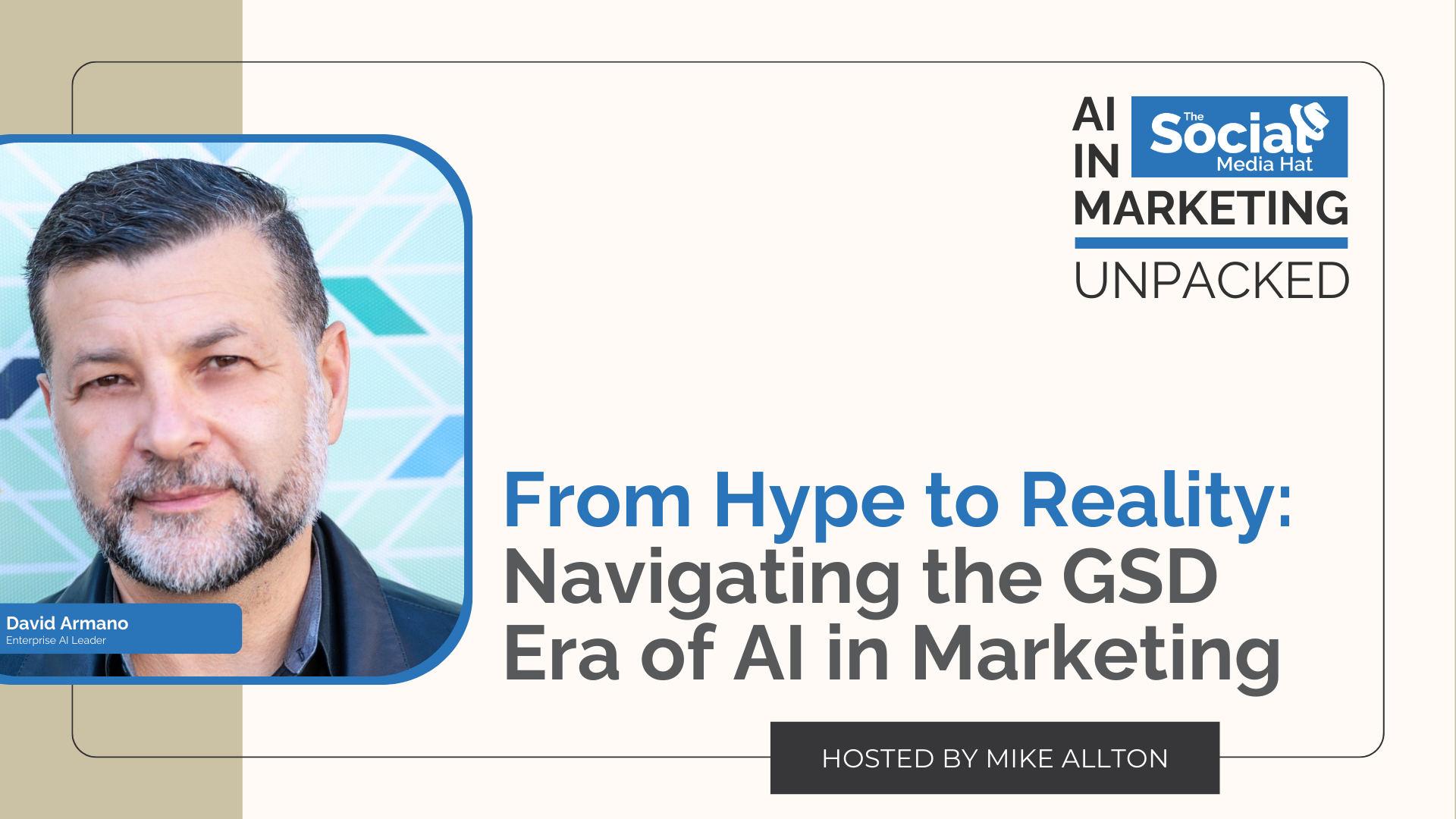Reading Time: 27 minutes
Have you ever felt overwhelmed by the constant buzz about AI in marketing? Are you tired of hearing grandiose promises but seeing little practical application? Well, buckle up, marketers, because today we’re cutting through the noise and getting down to business.
We’re living in a world where AI seems to dominate every conversation in the marketing sphere. But let’s face it – while the potential is enormous, many of us are still struggling to turn that potential into tangible results. It’s time to move beyond the hype and into what our guest calls the “GSD Era” – that’s “Get Shit Done” for those keeping score at home.
The problem? Too many marketers are caught up in the AI hype cycle, chasing after shiny new tools without a clear strategy for implementation. This leads to wasted resources, confused teams, and disappointed executives. But what if there was a way to harness the true power of AI in marketing, delivering real, measurable results that impact your bottom line?
LISTEN TO AI IN MARKETING: UNPACKED:
WATCH AI IN MARKETING: UNPACKED:
That’s where our guest comes in. Today, we’re thrilled to welcome David Armano, a true visionary in the world of marketing and technology. David is a strategic and creative leader with extensive experience in marketing, known for his contributions to major publications like Forbes, Harvard Business Review, and Adweek. He’s held leadership positions at several major marketing and consulting firms, and he’s here to guide us through the transition from AI hype to AI reality.
David has recently published a thought-provoking article on “Intelligent Experiences by Design,” where he introduces the concept of the GSD Era in Enterprise AI Integration. He’s at the forefront of predicting how AI will reshape our industry, and he’s here to share his insights on how we can all become more effective marketers in this new landscape.
AI in Marketing: Unpacked host Mike Allton asked David Armano about:
✨ Practical AI Implementation: Moving beyond hype to focus on tangible results in marketing.
✨ Evolving Skill Sets: The need for marketers to adapt and acquire new competencies in the GSD Era.
✨ Balancing Technology and Humanity: Leveraging AI while maintaining emotionally intelligent customer experiences.
Learn more about David Armano
Resources & Brands mentioned in this episode
Full Transcript
(lightly edited)
From Hype to Reality: Navigating the GSD Era of AI in Marketing with David Armano
[00:00:00] David Armano: We as individuals, um, are shifting into this world where AI is sort of becoming our co pilot, we’re doing it on the personal level. We’re also doing it definitely on the professional level, but a little bit more on the individual level, right? So we’re doing it when we are maybe researching or writing, or we’re using things like ChatGPT or Gemini or Perplexity to help with our reports.
So absolutely as knowledge workers, we are using these. It’s when we get to the enterprise, it’s doing these things at scale, that’s sort of the next step on this. And that’s where we’re in the early days, if you look at the AI agent space, right, where AI can autonomously do things like respond to emails, uh, workflow, all these things.
But that is sort of the beginning, and that is where I think we’re, we’re kind of peaking in the hype, but the hard work is, is yet to come.
[00:00:58] Mike Allton: Welcome to AI in Marketing: Unpacked, where we simplify AI for impactful marketing. I’m your host, Mike Allton here to guide you through the world of artificial intelligence and its transformative impact on marketing strategies. Each episode, we’ll break down AI concepts into manageable insights and explore practical applications that can supercharge your marketing efforts.
Whether you’re an experienced marketer just starting to explore the potential of AI, this podcast will equip you with the knowledge and tools you need to succeed. So tune in and let’s unlock the power of AI together.
Greetings program. Welcome back to AI in Marketing: Unpacked where I’ve selfishly used this time to pick the brains of experts at keeping up with and integrating or layering artificial intelligence into social media, content, advertising, search, and other areas of digital marketing. And you get to learn to subscribe to be shown how to prepare yourself and your brand for this AI revolution and come out ahead.
Now, if you’ve ever felt. Overwhelmed by the constant buzz about AI in marketing. Are you tired of hearing grandiose promises, but seeing little practical application? Well, buckle up marketers. You know, today we’re going to cut through the noise and get down to business. We’re living in a world where AI seems to dominate every conversation in the marketing sphere.
But let’s face it while the potential is enormous, many of us are still struggling to turn that potential. It’s time to move beyond the hype and get into what our guest calls the GSD era. That’s get shit done for those keeping score at home. The problem, too many marketers are caught up in the AI hype cycle, chasing after shiny new tools without a clear strategy for implementation that leads to wasted resources, confused teams, and disappointed customers.
Executives, but what if there was a way to harness the true power of AI and marketing, delivering real measurable results that impact your bottom line. That’s where our guest comes in today. We’re thrilled to welcome David Armano, a true visionary in the world of marketing and technology. David is a strategic and creative leader with extensive experience in marketing known for his contributions to major publications like this.
Forbes, Harvard Business Review and Ad Week. He’s held leadership positions at several major marketing and consulting firms, and he’s here to guide us through the transition from AI hype. To AI reality. David recently published a thought provoking article on intelligent experiences by design, where he introduces the concept of the GSD era in enterprise AI integration.
He’s at the forefront of predicting how AI will reshape our industry. And he’s here to share his thoughts on how we can all become more effective marketers in this new landscape. Hey, David, welcome to the show.
[00:03:37] David Armano: Thank you for that lovely introduction.[00:03:40] Mike Allton: Yeah, well, Hey, like I tell people all the time, you did all the work to earn that introduction.
And I appreciate you coming on here and talking to us about that article and about this idea, this concept of the GSD era. In AI, can you start by just kind of explaining what that means to marketers and how that might differ from where we’re at today with AI?
[00:04:02] David Armano: Sure. And I, I think I positioned it as going from TBD to be determined to GSD, get shit done.
A big caveat, Mike, for that piece is I was thinking about it and writing about it, probably more in the context of enterprise AI, . And so what that means is it’s exactly, it’s exactly what it sounds like it’s, it’s, it’s leveraging AI at scale. So, so we are seeing benefits at the personal level, right?
Like when we use something like Chat GPT or Perplexity or Gemini, these platforms now are at a point where they’re really useful. I talk about on, on the personal front. I just did this recently. I did not I’m planning a trip to West Texas, about a six plus hour road trip, and it’s, it’s the Texas that people think of, of the movies.
It’s the West. It’s the desert, there’s mountains, that’s pretty rugged and I was just going for a few days, and so I knew what I wanted to do. And in the traditional way of doing this, I would have Googled places to stay, things to do, right? And then I would have made my itinerary. But instead, I had a conversation with ChatGPT.
And so, I said, okay, I’m going for four days. This is the kind of, these are the kinds of experiences I like. I want places where I can stop and get coffee. I want to do a little bit of hiking. I want to see you know, I want to do scenic driving. And ChatGPT, of course, laid out. Honestly. And to end perfect itinerary that I’ve been working off.
So I’ve been doing the things like booking the hotels and places to stay. And I’m going to follow the route that it’s recommending because it was it was perfect. So, so we were shifting already. We, as individuals are shifting into this world where is sort of becoming our copilot. We’re doing it. On the personal level, we’re also doing it definitely on the professional level, but a little bit more on the individual level, right?
So, we’re doing it when we are maybe researching, or writing, or we’re using things like ChatGPT or Gemini or Perplexity to help with our reports. We can take large quantities of data and have it analyzed by things like Large Language Models. So, absolutely, as knowledge workers. We are using these.
It’s when we get to the enterprise, it’s doing these things at scale. That’s sort of the next step on this. And so, and that, and that’s where we’re in the early days. And, and I wrote the piece thinking about the early days of sort of the commercialization of the web, actually taking large businesses online and converting them into e Commerce, not just converting, but adding that to the to that, and I think we will be doing these things with a I specifically if you look at the A I Agent space, right?
These where A I can autonomously do things like respond to emails, workflow, all these things that we’re hearing companies like Salesforce talk about when they talk about Agent Force. But that is sort of the beginning, and that is where I think we’re kind of peaking in the hype. But the hard work is yet to come.
Specifically in that space.
[00:07:24] Mike Allton: Yeah, that makes a lot of sense. Like you mentioned, Co Pilot within just the past few months, we’ve heard about some enterprise organizations that have implemented Co Pilot and then rolled it back. So they’re having issues there. We’re not yet hearing a lot of success stories of enterprise.
I mean, I love your example of, of training or planning a road trip, cause I’m, I’m doing almost the exact same thing. I’m headed the opposite direction later this year and looking forward to you know, using a I to help me discover things that I wouldn’t think to do driving two days across the United States.
But yet, to your point, it’s we’re still early when it comes to enterprise. But in that article, you mentioned this idea called Corkscrew. Corrections as we move towards this, it’s a mouthful. You even illustrated it and I’m still not quite sure what you meant. And by the way, I’ll, I’ll link to that article in the show notes, but if you could share what you envisioning as some of the AI misfires, if you will, and how marketers might prepare for those.
[00:08:28] David Armano: So What I did was I visualized a version of of the Gartner Hype Cycle, if anyone’s ever seen that. And the way that works is that basically, over time, you sort of build up any, any significant innovation builds up to a peak, and that’s the peak of the hype cycle. And then it goes through a significant dip.
They call it the Trough of Disillusionment, I believe, you know, that’s sort of where the innovation doesn’t quite fulfill, you know, And then, but then you kind of come back up, not to the heights of the hype. But to, to a midpoint and it becomes steady. And so that was really my inspiration that, and that model I’ve always loved because it, it makes a lot of sense.
The twist I added to it was instead of sort of showing this trough of disillusionment or this big dip, like for example, in those early e Commerce days, which I worked and lived through, and I referenced that in the piece. And we saw the, the bubble burst of the. com and it was instant. I mean, businesses, I mean, it was.
It was a bubble burst, and it was a major, major course correction, but e Commerce didn’t go away right over time. It got figured out and became very, very real. And now it’s just part of how we do business today. I sort of instead of showing a big dip, I showed a couple of corkscrews and I kind of called out that we don’t know how many of these corkscrew corrections there will be.
But I suspect that there will be moments kind of like what you outlined, Mike, where so for example, I’ll use Salesforce as an example, and agents, the agent space the promise of an AI agent is that We go from working with co AI collaboratively and sort of helping us think or work through things or even create outputs into agents that just intelligently do the tasks for us.
I, I’m going to figure out how, you know your email campaign when it should be set, what the content should be, and I’m going to autonomously send it out. I’m going to respond to incoming emails. Read what’s being said in those emails, respond to those without you, the human, ever even interjecting. Oh, and then on top of that, if your email workflow needs improvements, the agent is going to figure that out as well.
Paraphrasing, I’m taking a lot of liberties here. But that, that is the prominent. So when you hear really interesting statements like the agentic that’s this word that’s now come up, this phrase, agentic, it’s, it’s. It’s alluding to this next shift in AI, which will happen where it goes from sort of being a collaborator to an autonomous agent, basically an employee.
So instead of having employee specialists, you have these AI agents that are specialists. And I do think that’s going to be a major change and a major transformation within the large enterprise. But I do think some mistakes, lots of mistakes will be made in the process. That’s one example in one space.
And as those mistakes. Are made it just takes one large company to make one of those mistakes and that will be a correction that that grounds the advancement of these technologies
[00:11:48] Mike Allton: Okay, great. So I think that makes sense to me. So would the Google Ai Overview rollout be another example where they announced it, people started using it.
And then within a couple of days, like 48 hours, there are all these stories of the most bizarre answers that you give. And they ended up having to roll it back a bit. Would that be another corkscrew correction in your mind?
[00:12:10] David Armano: I know I included that in the piece, but I used, I used I used a Audio Overview as an example of how much almost accidental innovation we’re seeing in the space because everything that I’m saying where it has in common is starting with the use case.
And there are a lot of use cases that are just not fully thought through where you, where you really need AI for that. And the reason why I use Google is because they actually almost sort of stumbled onto this amazing feature. If anyone’s this is a feature that’s in Notebook LM. And what it allows you to do is that you can take.
Document source or URL, and it will transform it into essentially almost like a good morning America. It’s two, two AI personalities with really human like expression. And they basically take whatever that URL or that source document was, and they turn it into a 10 minute conversation. That’s very podcast like, so I use that as an example because actually it’s a really innovative application.
That is a total content use case that, and as I speak, I know there are people building this for content marketers that are going to build it for real. Like I’ve actually said, this is, this, this is, this is not quarter Google’s business model. They’re only now actually drawing attention to it because it does this thing really well.
But it was almost like a weird, like an engineer was like, Oh, it’d be fun if it could do this and just sort of tacked on. But as I talk about that. And this was the sort of point of this piece. Someone needs to say, Okay, that was an amazing innovation. But in the world of content marketing, right, Mike, I know that a lot of your listeners probably operate in that space.
Someone now needs to build this amazing application that will do what has Google has showed us. But now you need there’s only two voices that you can choose. You need probably three. 50 personalities you could choose from. And then you probably need at least 20 formats. So that was sort of like this morning show format, right?
Have you ever listened to any of the notebook LM audio reviews? It’s one format, right? It’s like a good morning America,
[00:14:20] Mike Allton: right? It’s the guy and the lady having a conversation back and forth. Yep.[00:14:24] David Armano: Exactly. And it’s, and it’s amazing. It’s kind of, it’s groundbreaking when you listen to it. But if, but a use case approach means, Hey, there’s, there’s going to be a market for this.
People could actually take content they’ve already created or create written content and turn it into some things people would really want to listen to you. But to have that be a serious tool, it needs a full feature set.
And that was a big part of my point that you need almost sort of this I’m calling it intelligent experiences like we’re going to create an intelligent experience.
This application that we’re going to create is going to do these things because AI is so core to it. It’s an intelligent experience that we’re creating for, for both the people that sort of would use this application, how they work with it, but also the end users as well. And it’s a shift in mindset to create these sort of new intelligent applications that really are not like the tools we used to use where you have full control over and maybe you get templates as a starting point. This is these things become different. So that was that was sort of why I included that example as like as a proof point of how the innovation is there. The amazing the magic of A I is there more rigor is needed to actually think about taking the cool things you can do with it and applying it intentionally.
[00:15:46] Mike Allton: Yeah, podcast episode. Folks that are linked to where I fed Notebook LM everything that I can find about Notebook LM and then had had it talk to itself about it. So as little podcast episode within a podcast episode about Notebook LM is fantastic.
The example I was actually thinking about was in Google search where they were doing the AI summaries and AI overviews of what you were asking for before you actually got search results. And some of those AI overviews were. Whack to put it in very technical terms. And so they had to kind of roll that back a little bit, but you mentioned that intelligent experience design, talk to me more about that.
And how do you see it impacting the way like marketing teams are structured structure, because I think that’s really on top of a lot of people’s minds is how is this going to affect my team and my role.
[00:16:42] David Armano: So in the early days, the very early days of the internet which I was there for when we were creating these digital products and experiences, we, the, the field that is now known as user experience, which has both user experience designers, it’s actually gotten even broader now it’s basically product and then you have prod product leaders and product managers.
Bye. They have UX designers on their team. So I’m kind of painting a bit broadly here, but that UX slash product mindset needs to actually be applied even more with these these intelligent experiences where, where you’re actually creating, you’re, you’re using things like large language models or thinking more forward, you’re actually, you’re Working on the use cases for what these agents will do.
That, that one big difference between these experiences and the products that things like user experience designers created in the past is that we oftentimes not only is the experience itself different where even chat GPT, to some extent, it, it, it. It’s starting to get so good it feels like you’re having a conversation with a human being.
I mean, it’s not there, but ultimately AI will get there. And also too, we’re using a chat interface, but also we know that we’re entering a world where you’ll be talking verbally, maybe interfacing with the video, but you’re not going to be using the traditional Graphic user interface, which was which was basically it’s been the dominant form of how we interact with technologies now, and it’s UX designers and product managers that create those experiences.
So I make the case that’s not going away, but that now needs to coexist with these. These, these sort of intelligent experiences, which are going to need intelligent experience designers, people who really apply things like heuristics. They research the use cases. They think about something that I talked about was it’s not necessarily the end user, but it’s almost like the human having the relationship with the AI.
And what should the dynamics of that relationship be and user experience. It was always about the end experience being useful. usable, desirable. And I talk about things like it being intelligent, intuitive. And so we have to now make room and sort of formalize this practice so that it’s not the technology leading the experience.
It’s not the engineering leading the experience. That’s, that’s why I think ultimately that really cool feature ended up in Google because it’s just people experimenting with the technology and leading with the technology versus thinking about very intentionally, okay, this is a killer feature. How could this be commercialized into something that’s going to help the field of content marketing advance?
But that will be figured out by others. That much I’m confident of.
[00:19:56] Mike Allton: Absolutely fascinating where we’re at today, folks. We’re talking with David Armano about how AI is moving out of the hype cycle and into the get shit done cycle. And in a moment, we’re going to get into some practical steps. But first let me share with you the tool I’m using every day to get shit done.
This episode of AI in Marketing: Unpacked is brought to you by Magai, your gateway to making generative AI incredibly simple. Wondering how to seamlessly integrate AI into your marketing strategy without getting bogged down by complexities? That’s exactly where MagaiShines. It provides user friendly AI solutions that empower marketers just like you to innovate and elevate your campaigns without needing a degree in science.
Imagine having the power to generate creative content, insightful marketing data analysis, or even personalized customer communications all at the touch of a button. Magai isn’t just about providing tools. It’s about transforming your approach to marketing with AI that’s tailor made to be straightforward and effective.
So whether you’re looking to boost your content creation process or want deeper insights into your marketing performance, Magai makes it all possible with a few clicks. No fuss, no hassle, just results. Ready to simplify your AI journey? Visit Magai today to learn how their solutions can revolutionize the way you engage with your content.
With your audience, don’t just market market smarter with Magai tap the link in the show notes. So, so that tool Magai actually is kind of a funny example. I think of what you were just talking about developed by my friend, Dustin Stout out in Bakersfield, California. And the idea is simple, right? Where we’ve got multiple large language models at our disposal.
Chat GPT, Claude Perplexity and Meta and Gemini and so on image generation models. And it’s, it’s hard for marketers to know which to go to. Cause they’re all different. They’re all different location, different user interfaces. Magai is a wrapper that brings all that into one user interface. Now it’s not nearly to the extent of intuitivity and that sort of thing that you were talking about a moment ago.
It’s still the same basic kind of, I’m going to type in a prompt and get a response back. Interface. But the need is there to your point, right? Where we need to get to a point where these things are just so much easier to use, so much more intuitive. So I wonder if you could talk to the marketers who are listening right now, what do you think some practical steps are to take them from this hype cycle, this idea that AI is just hype into actual reality of AI, implementing it into their organizations?
What, what advice do you have for them?
[00:22:30] David Armano: I think as a marketing leader. It’s huddle up with, huddle up with your team and your agency partners. Something I talk about a lot is, is there’s so many aspects that you need to be on top of. You really need to know what your agency partners are doing. So, for example, I mean a lot of the AI tools, especially the Large Language Models, are, can streamline the work that agencies do.
On the, if you are a enterprise or brand or you’re a CMO or you’re working underneath the CMO, you should know in detail how your agency partners, what, what tools are they working with? Something that you really want to know about is, is your. companies, your brand’s data. Is that getting fed into Large Language Models?
Where data security could be an issue. So this is something anything that that anything that you feed into open a I is open. I is going to learn from and a lot of companies actually want to have more control over the data of that. So you’re so that comes extends into your agencies as well. You need to know what they’re using.
You need to know, challenge them and understand what their policies are. Okay. Know what, what, what tools the, their, their teams are using. Know what tools your own teams are u are using. There’s been some really great integration. You know, Adobe, for example, has, has integrated into their product suite.
Lots of really cool AI features where instead of using lasso tool and doing it, doing everything manually, you can select something and prompt what you wanna see in there, right? So make sure that you’re. internal creative teams that are starting to leverage these tools are sharing those learnings and thinking about what are the what are the platforms that they are going to use next and what actually has the legs. Adobe is a great example of Sort of no stranger to the marketing tech stack right that it is something a large organization uses already has a lot of trust in and so there’s, there’s a level of safety.
So you need, you need to be balancing those kinds of decisions with also some of the smaller and innovative things that are out there that have potential, but won’t put your, your company at risk either. So it’s communication, it’s. Experimentation within guardrails. There needs to be more coordination between the marketing department and I.
T. When I was at my last firm, we actually sold in an A. I. Pilot. Very innovative. The I. A. I. Pilot with a company in the health care space to actually create what we call custom language models and train them off of executives Content and voice. And I was really impressed by this company and how much they have thought about things like data security.
They wouldn’t, they wouldn’t let anything be done in open AI, like no data sent to open AI, no data stored, but you could, you could actually connect it through an open AI, which is what we did, but everything had to sort of be locked down and controlled. And they had a lot of I. T. Involvement and they had some documentation.
Okay. Outlining that and then we had to sort of basically provide how we were going to build this thing. So communication with the team’s agency cozying up with your it having some connective tissue with what’s happening at the broader Enterprise level, you know ai is is not that dissimilar from social media But even probably more so it’s a it’s a horizontal layer that needs to be applied to sort of every facet of the organization So market is only one layer One function and each facets going to have sort of their own mini kind of a I tech stack But you need it involved with ensuring and you know, having visibility into each tech stack I know I I know I hit a lot of different areas there, but hopefully there’s some connected tissue between those
[00:26:30] Mike Allton: Yeah, no, that was great advice and you did offer some very specific use cases and examples I think for some of the Cmo’s and the heads of marketing maybe who are listening to this podcast of which there are many And maybe they’re thinking okay.
I need to kind of prioritize how we’re going to You Go about doing this and how we’re going to go about adopting AI. What do you think the most promising applications are for AI and marketing now or in the near future?
[00:26:55] David Armano: It’s a good question. I’ve certainly the low hanging fruit. Fruit is output, but it also comes with pitfalls.
Obviously, anything you generate visually cannot be copyrighted. And there’s, there’s sort of ethical issues around that. I think data analysis is a really good use case, but, but with data analysis, and we found this as well, you have to double check so you can crunch a lot of data. You can sort of synthesize it more effectively.
I don’t think that the analysis of data or the synthesis of data, it still needs. sort of that human in the loop. This is a phrase that we talk about when working with AI. But I think crunching of data, analysis of data anything that involves writing, I think that it’s all of this sort of language models are great at, at going from zero to one and creating rough drafts.
That I think present a lot of opportunities to sort of work off of and then, you know, the things that you probably hear a lot about, just the, the automation of, of tasks, right? There’s, there are, even within the world of Chat GPT, there’s all these sort of niche, you know Custom GPT models where, where that if you’re, especially if you’re a small business, I think a lot of the today opportunities are very much within the small business realm again, I think it will take a little bit longer than the enterprise, but there’s a lot of automation that can be done and just just doing things more efficiently, especially at the small business level.
[00:28:36] Mike Allton: Absolutely agree. In fact, I love your point about the ethics. We did a whole episode back in episode 19 with Mitch Jackson, a lawyer about some of the copyright concerns and the issues marketing agencies could potentially have if they’re using generative AI to create content on behalf of consumers.
But you just touched on ethics. I’d love if you could unpack that a little bit more. What you see, some of the ethical considerations are, whether that’s to marketers, whether that’s to some of the enterprise clients that you’ve worked with, maybe irrespective of marketing. What are you seeing out there today?
That’s, that people need to be aware of when it comes to ethics and AI.
[00:29:11] David Armano: You know, it’s interesting when, in the kind of pre Generative AI world, there was always a lot of talk around bias, that, that the people who are creating these sort of language models would have bring their own bias to it. That, that’s interesting.
There’s still things that I think are worth looking. We’ve also seen the opposite of that, right? We’ve seen Google sort of go too far and then misaccurately characterize historical figures and sort of use races that were not historically accurate. So we’ve seen, we’ve seen how that can almost cut both ways.
I think that the The biggest ethics issue, honestly well, to really, I think one is the whole sort of automation and jobs and something that we always hear a lot about is how much more efficient and how much better these things can be in terms of allowing us to do more and automating the things that we don’t want to do, like crunching data, for example.
That is all true, but especially when we get into agents, when we start to figure that out, it will, it will take jobs. And if it’s making us more efficient, it means that by definition we can do more with less, which means we need less people. So I think ethics, there’s a, there’s a big ethics conversation around, okay, As this thing is taking some jobs, it’ll create some other ones.
What’s the ratio? I think that the amount of jobs, personally, honest opinion, the amount of jobs it creates will not be as much as what it takes. So there’s an ethical conversation to have around that. There’s also an ethical conversation to have around things like misinformation or using AI for, for bad, you know, something that we’ve seen.
With blockchain and crypto, sort of previous big innovation that is a real big issue is just the criminal use of that, of decentralized sort of revenue models, or I’m not using the right terminology, but we know that Criminals like to use crypto to just keep it simple and there will be criminal there already are right there.
AI is used in scams It’s it there’s you can clone voices and sort of do all these you can exploit vulnerable populations elderly things along those lines. So there’s ethics around that there’s ethics around misinformation you’re seeing what’s happening in California right now where there’s a debate to be had there between you what’s free speech and what’s satire and ethical or non ethical use of AI.
So early days for all these things as well, but those are some of the big conversations. I think I, I really think that the jobs one is one of the bigger ones.
[00:31:49] Mike Allton: I agree. That is one of the bigger ones. That’s why I had this podcast is to help marketers prepare. And in fact, if you’re listening and this is kind of your first foray into AI and marketing, I’ll have a link in the show notes to my AI Marketing Primer that’ll help you kind of get up to speed.
It’s free. You can figure out what the different elements are, all the other jargon that we’re, we’re trying not to say too much of, but you can’t help it in an organization like this and a topic like this.
[00:32:13] David Armano: Use one specific example job, because I felt like I was talking voice, voice, talent,[00:32:20] Mike Allton: yeah,[00:32:20] David Armano: voice talent as an industry.
Now, this is not something that like, this is a little bit, but we should be thinking about these, the first we’ll go will be these sort of gig type jobs, you know, but people, there are people that make a living and they do a part time some do it full time, but AI voice is now at almost at human level quality.
And then the ability. Not only is it the quality, but when you are doing so I’ve done enough, I’ve directed enough video production, right? Being connected to both creative and marketing where you do, you get voiceover recorded and then maybe there’s a script change or something changes and you need to rerecord segments when you’re working with AI voice, all of that gets streamlined.
Oh, you don’t like how this voice sounds. Let’s try that same exact cut only with This voice, right? So like just just giving that just just making this real people that have created wonderful careers doing voice talent. And maybe the best ones become even more valuable. But anyone that’s doing this sort of block and tackle commercial commercials or digital videos, sort of that mid layer, there’s just going to be less, there’ll be less people getting paid to do voiceover talent that’s already happened already.
Well, that ship is already out of the port.
[00:33:35] Mike Allton: I couldn’t agree more. That’s, that’s an excellent example. It’s a sad example, but absolutely. I think that’s, that’s where the market is heading. So where else do you see the market heading? Where else do you see markers roles evolving? It’s funny. I’m very transparent about how AI helps me come up with these questions and I laugh at it because typically when it asks this question, it says in the next five to 10 years, I think that’s a joke.
How are we possibly going to anticipate five to 10 years in artificial intelligence? Things are moving. So fast. But as far as you can in this new GSD era, how do you envision things changing?
[00:34:11] David Armano: So when when the first signs of generative A. I. Both in terms of the things that we’re seeing with images, but we were also seeing with video and then large language models. While that was going on the first article I ever wrote about it in Forbes, I talked about this idea of intelligent automation.
I think we’re all going to need to have a sort of a masters of intelligent automation. And what I meant by using that phrase was being smart and strategic. about what, when, where, and how we automate things leveraging AI, like how we get these new efficiencies. And so for example you know, some of the pushback that I see on AI as well, it’ll never be, it’ll never write as good as a human.
It’ll never have that. It’ll never do a video. That’s good as a human. And we’ll never create art. That’s good. As you that’s actually all right, but this is the sort of, this is the reality, especially in the world of marketing, how much of what we as marketers that we produce just has to hit a certain bar that that good enough bar.
And so as marketers, we have to sort of retool our organizations to say, okay, the things where we just need to do volume and kind of hit the good enough bar, how much can we automate because that’s. It’s inevitable. And then you want to have the automation be good and you don’t want to have be inaccurate and you don’t want it to be.
to you need to own what you can own. So certain things were like copyright is an issue and you can, you can automate more of that, but the things that you may want to pick the moments where it’s, maybe it’s your big flagship campaign, or maybe it’s you know, a big event that you’re doing, or maybe it’s sort of a thought leadership idea that you really want to own.
I still think that when it comes to craft. There’s an artisanal touch that humans bring that, at least for now, we’ll see. Maybe this, you know, with AI, you never know. But I still think there are things that that sort of that human touch just does better. And so then you need to be smart. You need that kind of intelligent automation is being smart about when to apply the inefficiencies.
And when to not and sort of take a look at your marketing mix and your marketing strategies and your tactics and figure out what should be automated and what shouldn’t be.
[00:36:30] Mike Allton: That makes a lot of sense today. AI can’t write a bestselling novel, but can AI write a great email as part of a sequence?
Absolutely. Sure. It can, if you give it the right pre work and the right prompting, obviously, if you just go into chat GPT and says, write me an email, it’s going to be garbage, but train chat GPT and you. Teach it who you are, who you’re talking to, what their pains, objectives, goals, all, all the things that every good marketer should know before they go about writing an email ChatGPT can do.
[00:37:01] David Armano: Yeah. I mean, email is a really good example. I, it’s, it’s, I, I think email marketing is prime. And again, I hear people talk about, Oh, great. You know, the emails that I never wanted to get now they’re going to be written by machines. Like, well, that’s the point. If email as a medium has degraded and you can make an argument to say like, Oh, well that’s.
All the more reason for it to be just amazing, but not every email can be a work of art, right? So if you’re going to send, if you’re, let’s make this real, if you’re software B2B and you’re doing, you know, nurture emails. And so on average, you’re, you’re sending out three emails a month. And so, you know, maybe one out of every 10 emails should be like really special to the point to where it stands out.
Right to where that, where, where it’s got special content and features and it just, it’s just really got that touch where the other ones are sort of by design, just kind of, if they get read, they get read, if not, you know. You’re just keeping up with the ratio of the open rates that that helps run your business.
I mean, it sounds a little counterintuitive, but you have to be realistic about these things. And I think data needs to, needs to play in. And we’re going to have to try, like, that’s a theory. I don’t know. Try that could be maybe the one that you sweated over. And you thought as the human was the best email, maybe that gets the lowest.
Click the rates, you know, an open rates.
[00:38:30] Mike Allton: Sadly, as a writer for over a decade, I can attest to that. None of the articles that I thought were my best work ever performed the best. Not one. It’s the things that I just churned out. I mean, social media managers listening, you’ll, they’ll relate to me too. You know, stuff that you just churned out because it needed to be done.
People resonate with the strangest things.
[00:38:52] David Armano: As marketers be consumers and pay attention. So something that I’ve been thinking about a lot. I, I’m a Spotify user, I love it, it’s great, and they have a AIDJ feature, and it’s the first time I ever used it, it was like magic. It’s like, hey David, you, you’ve been listening to, like, a lot of stuff from the 80s, and you know, when you’re in that 80s mood, and so it’s gonna play me a lot of that.
It’s, it’s pretty wonderful. And It’s getting better. And I was like, that was a really smart use of AI. It actually takes kind of the old element of a DJ and, and it, you know, it’s pretty magical, but, but I have to say someone who listens to a lot of music and that’s sort of that’s an algorithmic experience.
Right. And it’s a good one. Now there’s a radio station I’ve listened to for years. It has an app and everything it’s called radio paradise. And it’s got, it’s all human powered. It’s cured. It’s human curated. I have to say I listen to that so very regularly. It’s like Spotify is a little bit more on demand for me, even as good as their AI DJ is when I want to be open to like new music and hear something unexpected.
It’s radio paradise, the human curation. is still better than that AI algorithm, even with the personality. And there’s sort of a little apple and orange. I really like Spotify. I like what they did with their AI DJ. So as marketers pay attention, see what’s happening, know the difference, know when human curation is needed and when that’s going to be a thing that build your brand and know when AI magic can also sort of help take you to the next level and it doesn’t have to be one or the other, it can be both.
You have to know when
[00:40:36] Mike Allton: that is the question. David, this has been absolutely amazing. Thank you so much for this really thought provoking conversation for folks who want to know more. They want to connect with you. Where should they go?[00:40:50] David Armano: A good starting point is my profile website, davidarmano. me. You can also just Google my name.
I write a pretty much a weekly newsletter that’s called David by design. I try to iron honor my Sort of background. I started in this career as a in the marketing industry as a visual designer. So it was a way to sort of pay homage to that, which Mike also kind of comes back to that last post as well, kind of going back to.
Thinking about sort of the early days of user experience design and thinking about intelligent experience design as we move forward.
[00:41:26] Mike Allton: Love it. Thank you, David. We will have all those links for you guys in the show notes below his newsletter, his website, his LinkedIn posts. So check him out and don’t forget to find the AI in Marketing: Unpacked podcast on Apple and leave us review.
I’d love to know what you think until next time. Welcome to the grid. Thanks for joining us on AI in Marketing: Unpacked. I hope today’s episode has inspired you and given you actionable insights to integrate AI into your marketing strategies. You enjoyed the show, please subscribe on your favorite podcast platform and consider leaving a review.
We’d love to hear your thoughts and answer any questions you might have. Don’t forget to join us next time as we continue to simplify AI and help you make a real impact in your marketing efforts until then keep innovating and see just how far AI can take your marketing. Thank you for listening and have a fantastic day.

Related
Discover more from The Social Media Hat
Subscribe to get the latest posts sent to your email.










